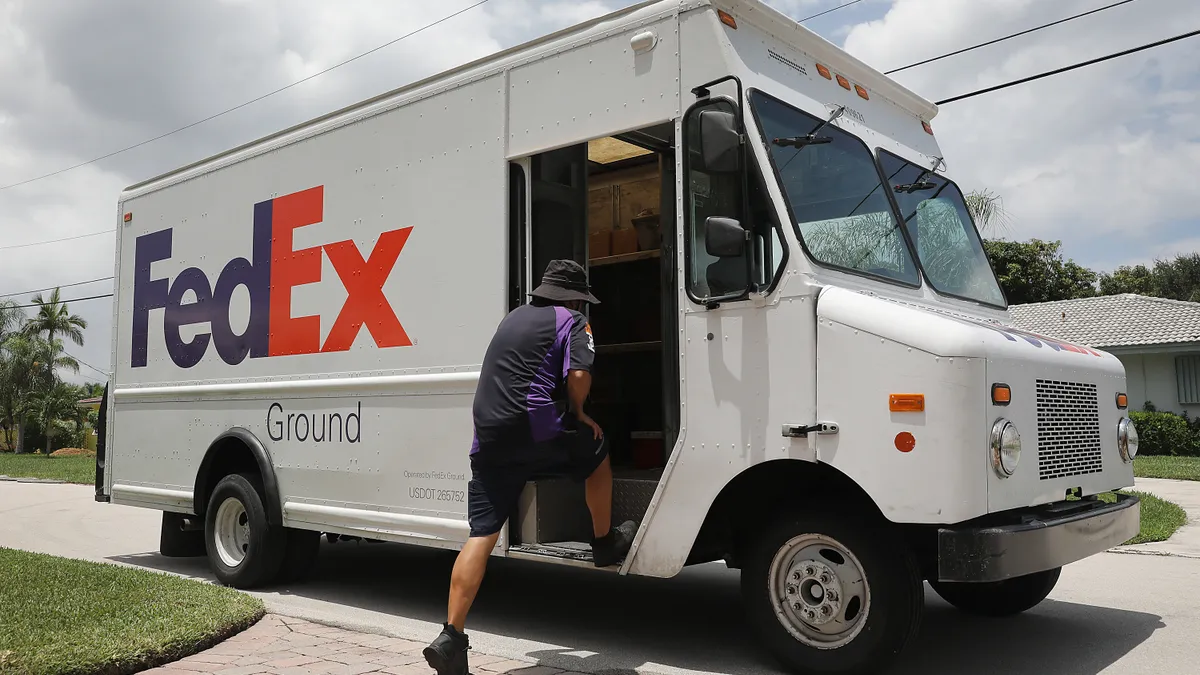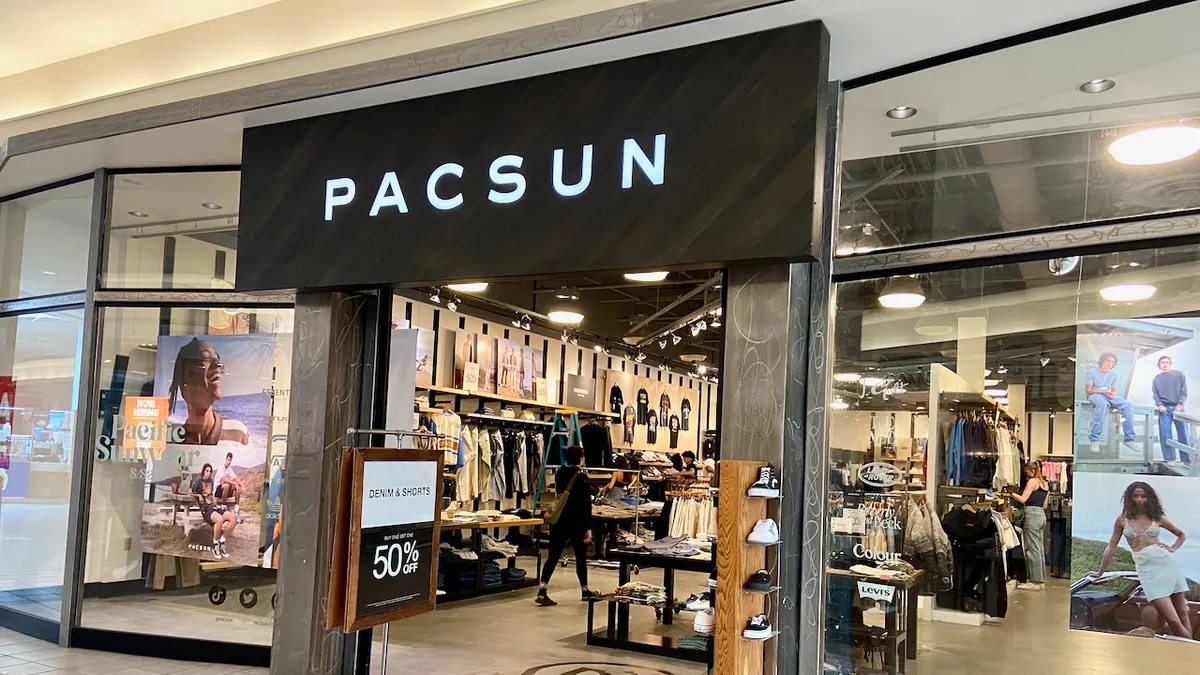Legacy delivery providers weathered volume declines in 2023 as Amazon and emerging alternatives gained more share in the U.S. parcel market, according to data released Wednesday from the Pitney Bowes Parcel Shipping Index.
The shipping and mailing company's index tracks both volume and spend for parcel shipments weighing up to 70 pounds, offering insight into which carriers fared best during last year's challenging operating environment.
Five charts based on the index's data are below, including Amazon surpassing UPS in terms of U.S. parcel volume, regional carrier demand and what the years ahead could look like for the delivery sector.
Revenues dip while parcel volumes see uptick
U.S. parcel volumes reached 21.65 billion shipments in 2023, a 0.5% increase from the year prior. While still 50 million parcels below 2021 delivery activity, the results show the resilience of consumer delivery demand even with inflationary pressures over the past year, said Vijay Ramachandran, Pitney Bowes’ vice president of go-to-market enablement and experience.
"The number of orders and number of shipments has stayed strong despite the fact that spending power has been under pressure," he said.
Ramachandran attributed this in part to the influx of affordable goods from Asia-based e-commerce marketplaces and nearshoring activity in North America. This could be offsetting a slowdown in activity from domestic shippers.
While volume grew, parcel revenue fell slightly to $197.9 billion last year, down 0.3% from 2022. UPS and FedEx drove the decline as both carriers contended with fewer deliveries and offered up discounts to shippers. However, Ramachandran noted that the carriers leveraged price hikes and surcharges to minimize the impact to their bottom lines.
Volume growth outpaces revenue for first time since 2020
FedEx, UPS struggle as upstarts grow
UPS saw the sharpest volume drop among the top parcel carriers in 2023, as the company dealt with shippers diverting packages to competitors during its summer contract negotiations with the International Brotherhood of Teamsters. FedEx took advantage of the uncertainty and is now fighting to keep business it snagged from UPS.
"We continued to retain the vast majority of the volume we gained from UPS in the second half of 2023," Chief Customer Officer Brie Carere said in a March earnings call.
Despite the gains against its rival, FedEx also posted a volume decline last year as it weathered soft demand, particularly in its Express unit. The company is trimming its excess air cargo capacity in response, and more network changes could be coming this year once its U.S. Postal Service deal expires.
Meanwhile, Amazon and alternative carriers posted strong volume gains in 2023. Ramachandran attributed this to their larger focus on lightweight, business-to-consumer deliveries — a growing part of the market — compared to FedEx and UPS.
"The two largest private carriers don't really specialize in the lightest-weight parcels," Ramachandran said. "That's not the primary part of their business, and so we see the declines from both UPS and FedEx in this time period because the market has seen a sector shift towards smaller, lighter-weight packages."
FedEx, UPS fall behind in 2023
Amazon sprints ahead of UPS
Amazon's logistics arm was the only carrier among the top four — including FedEx, UPS and the Postal Service — to see volume gains year-over-year. Since 2019, it has nearly tripled its shipping volumes.
As Amazon's in-house delivery capabilities have grown, it has reduced its reliance on other carriers like UPS. While UPS doesn't report volumes tied to a specific customer, its revenue derived from Amazon last year was its lowest annual total since 2019 as the two companies advanced their mutually agreed cutback.
Amazon shipped more U.S. parcel volumes than UPS did last year, the first time in the index's history. The company had already surpassed FedEx on that front.
"[I]n the last few years, our scale and available alternatives have forced us to build our own last mile delivery capability (roughly the size of UPS) to affordably serve the number of consumers and sellers wanting to use Amazon," Andy Jassy, Amazon's president and CEO, said in a letter to shareholders last week.
Amazon Logistics remains behind FedEx and UPS when it comes to U.S. market share by revenue, however, ranking fourth among carriers. Pitney Bowes said in a news release on the index that this discrepancy between revenue and volume indicates "a secular shift in the economics of last mile delivery toward smaller parcels and cost-effective shipping services."
Amazon's delivery surge eats into UPS, FedEx's share
Alternative carriers maintain momentum
As legacy carriers shrank in 2023, smaller U.S. parcel carriers continued their blistering pace of growth. Volume and revenue for carriers outside of UPS, FedEx, the Postal Service and Amazon grew by 28.5% and 32.5%, respectively, YoY.
These alternative carriers often specialize in lighter-weight parcels and short-haul shipments that have grown in prevalence, Ramachandran said. However, they still make up less than 3% of U.S. market share by volume, and industry observers expect shippers will pare down their carrier mix this year as they pursue cost savings and operational efficiencies.
Despite the headwinds, interest in adding alternative carriers remains high for two reasons, Itamar Zur, co-founder and CEO of delivery provider Veho, said in an interview earlier this year.
One reason for that is shippers want to keep some negotiating leverage against FedEx and UPS as the two delivery giants continue to institute rate hikes. Shippers are also looking to partner with carriers that are more forward-thinking when it comes to the end customer experience.
"The trend is there because of the need to make sure you're not putting all your eggs in one basket, and because of the need to drive innovation and experimentation," Zur said.
Alternative delivery providers maintained momentum in 2023
Volume growth projected to slow
Pitney Bowes forecasts U.S. parcel volume will reach somewhere in the range of 23 billion to 35 billion by 2029, with its most-likely scenario landing in the middle at 29 billion with a 5% compound annual growth rate. The CAGR from 2015 to 2023 was 9.3%, pushed upward by volume surges during the COVID-19 pandemic.
Despite inflation and market uncertainty weighing on Pitney Bowes' projections, Ramachandran said volume forecasts remain higher than they were in 2019.
"It's not quite a reversion to the mean, as many have speculated," he said.
However, Ramachandran noted that delivery demand could see swings in the years ahead as fast-fashion trends expand to other retail categories.
"There's a trend towards tight coupling between manufacturers, retailers and distributors out to parcel carriers that is going to be much more agile over the coming years," he said. "It is going to respond more quickly to virality on social media trends, and it is going to be highly volatile in terms of demand."























